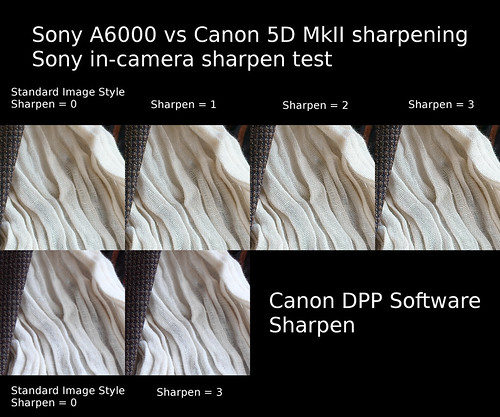To recap: What's a guy to do when faced with a 100Euro instant rebate from Sony and offered a 4 year guarantee for free by the camera shop? Kick the Canon 5D MkII to the curb? Maybe.
After bringing my new pride and joy home from le Salon de la Photo I ran a very very quick test to see how the Sony A6000 performed. Compared with the Canon 5D MkII (henceforth known as The Old Beast) it looked like I could match the 6 year old camera's image performance... but... I wasn't entirely convinced.
I stayed up half the night thinking about this. Was the AF as accurate as I thought? Did I use the correct settings on both cameras to produce a valid result? Did I make a mistake in buying the Sony? Afterall, DPReview showed images from the A6000 that I thought were clearly superior to a 5D MkIII's output (a generation Canon newer than the one I owned). I wanted to see the difference "clearly" demonstrated.
So... after defrosting the freezer and cleaning the kitchen floor this morning I hauled out a test setup to see if I could find a different answer to the one I'd worried over the night before.
The heavy tripod mounted, 2second trigger delay test setup -

Looking at this closely (ie: at 100%) you can see that Sony's "standard" image style default image sharpening set to Zero seems to match, if not slightly exceed, Canon's DPP processed image with sharpening set to 3. Canon's 0 DPP sharpening is clearly softer than Sony's identical setting.
Further, Sony's in-camera image sharpening settings greater than 0 show increasingly "crisp", some might say "over sharpened" images up thru sharpening set to 3.
These findings are very important to me. My default has been to use the 5D MkII "standard" image style with sharpening set to 3 and to use DPP to perform the conversion after initial processing. I've used this approach for 6 years and love the large print resolution I've seen from The Old Beast. I can enlarge images to 30x40inches and still see very pleasingly sharp images. This was my baseline against which all other things were to be measured.
With the Sony A6000 it looks like I can use it's "standard" image style with image sharpening set to 0 and still easily exceed The Old Beast's resolution. With a very light touch in Sony's Image Conversion software I can further enhance the appearance of sharpness/resolution without "over doing" the whole effect of resolution.
In short, I can clearly demonstrate that the Sony A6000 image quality exceeds The Old Beast's.
Onward to using the new, small, light tool for serious image creation.
After bringing my new pride and joy home from le Salon de la Photo I ran a very very quick test to see how the Sony A6000 performed. Compared with the Canon 5D MkII (henceforth known as The Old Beast) it looked like I could match the 6 year old camera's image performance... but... I wasn't entirely convinced.
I stayed up half the night thinking about this. Was the AF as accurate as I thought? Did I use the correct settings on both cameras to produce a valid result? Did I make a mistake in buying the Sony? Afterall, DPReview showed images from the A6000 that I thought were clearly superior to a 5D MkIII's output (a generation Canon newer than the one I owned). I wanted to see the difference "clearly" demonstrated.
So... after defrosting the freezer and cleaning the kitchen floor this morning I hauled out a test setup to see if I could find a different answer to the one I'd worried over the night before.
The heavy tripod mounted, 2second trigger delay test setup -
- Canon 5D MkII/24-105L at ISO100, f/8, image style set to "Standard"
- Canon output converted from RAW at two settings: 1) Zero in Canon's DPP software sharpening. 2) DPP sharpening slider set to 3, with no other manipulations out of the camera.
- Sony A6000/Sigma 30mm, ISO100, f/5.6, image style set to "Standard"
- Using Sony's in-camera sharpening at four settings: sharpening set to Zero, One, Two, and Three and converted without further manipulation using Sony's Image Converter software.

Looking at this closely (ie: at 100%) you can see that Sony's "standard" image style default image sharpening set to Zero seems to match, if not slightly exceed, Canon's DPP processed image with sharpening set to 3. Canon's 0 DPP sharpening is clearly softer than Sony's identical setting.
Further, Sony's in-camera image sharpening settings greater than 0 show increasingly "crisp", some might say "over sharpened" images up thru sharpening set to 3.
These findings are very important to me. My default has been to use the 5D MkII "standard" image style with sharpening set to 3 and to use DPP to perform the conversion after initial processing. I've used this approach for 6 years and love the large print resolution I've seen from The Old Beast. I can enlarge images to 30x40inches and still see very pleasingly sharp images. This was my baseline against which all other things were to be measured.
With the Sony A6000 it looks like I can use it's "standard" image style with image sharpening set to 0 and still easily exceed The Old Beast's resolution. With a very light touch in Sony's Image Conversion software I can further enhance the appearance of sharpness/resolution without "over doing" the whole effect of resolution.
In short, I can clearly demonstrate that the Sony A6000 image quality exceeds The Old Beast's.
Onward to using the new, small, light tool for serious image creation.

2 comments:
I agree. The Sony at 0 look sharper than the Canon at 3. I passed on your blog to my son in law who is also heavy into photography.
Thanks, Jacques. I think it's interesting to see how the technology continues to develop in ways we as artists can take advantage of.
Post a Comment